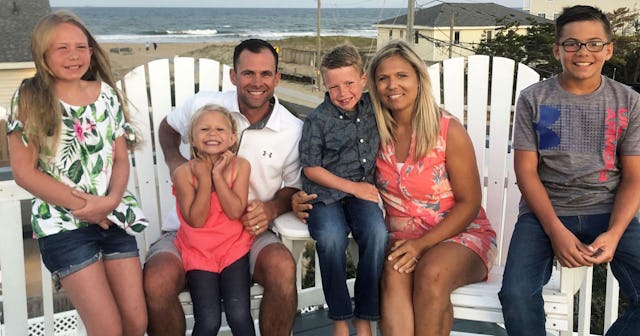This Mom Battled Through Kidney Failure, And Came Out Triumphant

Just weeks before the world shut down and “normal” became a thing of the past, 35-year-old Melanie Stoddard, a mom of four, was returning to her normal. She had just received the gift of a lifetime—a new kidney—and not even a pandemic could stop her from enjoying every moment.
Melanie was diagnosed with lupus when she was 16 years old. After six months of treatment, she was able to return to her normal life without the cloud of her diagnosis hanging over her. But that cloud returned fourteen years later when Melanie was pregnant with her fourth child and she noticed swelling in her legs.
Fast forward a few years and Melanie had been in and out of the hospital, with long periods during which she felt well. But eventually, she landed in the hospital with end-stage renal disease (ESRD), or kidney failure, and learned she’d have to begin dialysis — a treatment that mimics the work of failed kidneys — to stay alive.
Courtesy of Melanie Stoddard
Melanie initially started with in-center hemodialysis, but with training and help from her nurses at Fresenius Kidney Care, soon turned to peritoneal dialysis (PD), which is a treatment that uses blood vessels in the peritoneum—the lining of your stomach—to filter waste from your blood. PD was the right choice for Melanie for a number of reasons. It’s generally gentler on your body than other dialysis treatments. But, most importantly for Melanie, PD allowed her to administer her treatments from home, though she regularly checked in with her care team, including her nurses, her nephrologist, social worker, and dietitian.
PD gave Melanie back her life and allowed her to be home, to be present with her kids. The treatment wasn’t disruptive, the machine was quiet, and luckily, Melanie’s kids were good sleepers who didn’t often wake in the middle of the night. (Luckily, in the odd event they had a middle of the night emergency, she had the flexibility to unhook the machine once during the night, if needed.) Due to the portability of PD, Melanie was also able to travel—she took a trip to the beach for a week and had a chance to visit New York City, and visit the American Girl doll store for her daughter’s 10th birthday.
Shortly after beginning treatment, she started to feel better. She couldn’t always make it downstairs in the mornings for breakfast, and couldn’t return to her former level of exercise, but she could keep up with her kids, all of whom she’d been homeschooling since they started school. For Melanie, that time together was a gift that she’d learned not to take for granted.
Courtesy of Melanie Stoddard
Melanie, like so many moms and caretakers across the globe, was driven by a need to be there for her kids—both in the moment and for the future. Her nurses had explained to her that the ultimate goal for her was to receive a new kidney. But the decision to accept a new kidney wasn’t as straightforward as it might seem at first glance.
Melanie signed on for two state kidney exchange lists—in her home state of New York and also in Pennsylvania, where a friend of hers lived. And she did receive calls from the transplant list that a kidney was available for her. Melanie turned those down. The truth was, she wasn’t ready. The decision to accept (or not) a kidney was filled with a fair amount of fear, and also, though this sounds contradictory, a fair amount of hope.
There are two possible ways one might receive a kidney—either from a recently deceased person or a donation from a friend, wherein each person ends up with one functioning kidney.
It’s a hard thing to ask a friend or family member to donate a kidney, a part of themselves that they can’t get back. Though we know that a single healthy kidney can do 70-80% of the job of two kidneys, according to Fresenius Kidney Care, the worldwide leader in the treatment of renal disease, which has helped more than 190,000 patients, donating a kidney is not a choice to be made casually. It’s a choice plagued in “what ifs” on both sides of the choice—both by the donor and the receiver.
Courtesy of Melanie Stoddard
Melanie was humbled by the outpouring of love and support she received while sick—from her husband and friends and family who helped carry the load when she couldn’t. But nothing was as humbling as when friends and family alike were all willing to see if they were a match for kidney donation.
It took time, and patience was key, but eventually Melanie learned her friend was a match—but not for her. Melanie’s friend was matched with a man, who had a friend willing to donate a kidney for his friend. That friend was a match for Melanie.
The foursome met—and the rest is, as they say, history.
Melanie had been forewarned (in the best way) that if she thought she’d felt good on PD, she would be blown away by how well she felt after a kidney transplant. The warning proved true. Post-transplant, her energy level is back to what it once was. She can lead a full day homeschool class for her kids and also get back to all the workouts she’d missed while on PD. And, much to her children’s delight, she’s back downstairs making breakfast for them in the mornings.
Navigating illness and motherhood can feel impossible. Taking time to focus on your own health when your instinct is to give to your children means sifting through a complex series of emotions. With a positive attitude, faith, and a support circle that buoyed her in the hardest moments, Melanie did all of that … and more.
This article was originally published on